The Good Soldier Schweik
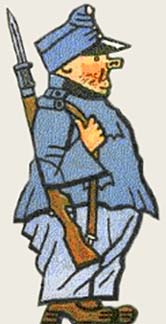
A rare presentation of Robert Kurka’s opera, The Good Soldier Schweik, was offered to audiences in Southern California by the Long Beach Opera at the Center Theater in Long Beach on Jan. 23, 2010, and at Barnum Hall in Santa Monica on Jan. 30, 2010. Based on the 1923 antiwar novel by Czech writer Jaroslav Hašek, the opera is scarcely known in the United States and has been infrequently performed since it first premiered in 1958.
I attended the performance in Santa Monica, California and offer this article as a review, but I also wish to familiarize readers with the history of the Schweik tale since it was first published eighty-seven-years ago.
The confluence of talents, historic events, and political lessons embodied in Schweik is nothing less than astounding. While Hašek’s story took place during the First World War – “the War to end all Wars” – the work has continued to resonate throughout the decades. It is especially pertinent now that President Obama is fighting wars in Iraq, Afghanistan, and Pakistan.
I commend Andreas Mitisek, the artistic and general director of the Long Beach Opera company, for staging a boldly anti-militarist production during a time of war. In the Long Beach Opera’s program guide for Schweik, Mitisek states:
“The story of Schweik has lost none of its original bite and sarcasm. Seeing it today, you get the sense that we’ve learned some things about war – but not a lot.”
It is regrettable that after all the effort the company put into mounting Kurka’s Schweik, only two performances were given. The work deserves a longer run, and hopefully the Long Beach Opera’s efforts will give rise to renewed interest in Kurka’s magnum opus.
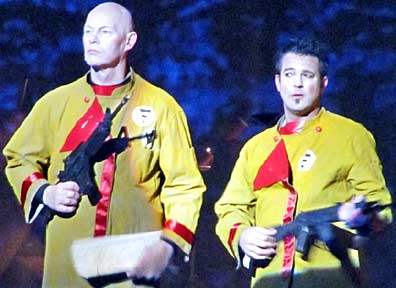
Of Czech descent, Robert Kurka (1921-1957) was born just outside of Chicago, Illinois. Mostly self-taught when it came to music composition, he nevertheless had a burgeoning career in the field due to his extraordinary talent.
After receiving a Guggenheim Fellowship in 1951 and an award from the National Institute of Arts and Letters in 1952, he made up his mind that same year to compose an opera based on Hašek’s antiwar novel. Why exactly he chose to do so is unknown, but whatever the reason for his decision he picked an inopportune moment in history for his endeavor.
The United States began fighting the Korean War on June 25, 1950, a bloody conflict that would end in stalemate on July 17, 1953. It should go without saying that the powers that be in the U.S. were in no mood for pacifist messages in art, not only that, but American society was in the throes of the anticommunism of Senator Joseph McCarthy and the House Un-American Activities Committee (HUAC). Set in that context, Robert Kurka’s resolve to write an antiwar opera can be considered an act of defiance.
As work proceeded on his opera Kurka was stricken with leukemia. He continued to labor at his composition, fashioning a brilliant modernist fusion of folk, jazz, and classical idioms. His score was created for a small orchestra without strings, focusing exclusively on percussion, brass, and wind instruments in order to produce a sound evocative of marching rhythms and martial music.
The opera shared much with the theatrical works of Kurt Weill and Bertolt Brecht – especially with their magnificent opera, The Rise and Fall of the City of Mahagonny. Kurka developed a musical language that described the absurdity of war as expressed in Hašek’s original antiwar novel, and he was just able to finish the opera when he died of his illness on December 12, 1957, ten days before his 36th birthday. Only months after Robert Kurka’s tragic death, The Good Soldier Schweik premiered at the New York City Opera in April 1958.
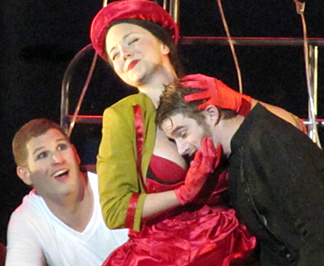
Following the overture of The Good Soldier Schweik, the opera’s prologue commences with the appearance of “A Gentleman of the Kingdom of Bohemia,” a dandy in a bowler hat who proclaims that “Great times call for great men.” He continues his narrative by telling the audience that “modest, unrecognized heroes without Napoleon’s glory” exist, men and women who are “Greater than Alexander the Great.” He speaks of “a common man, the kind it’s easy to like,” introducing “a very plain fellow called Schweik.” With the opera’s egalitarian tone set, the black comedy farce unfolds.
Kurka had picked Abel Meeropol (1903-1986) to write the libretto for his opera, and Meeropol produced a witty and sometimes devastating libretto. He was Jewish and a teacher in New York City, but he was also a skilled writer of poems and songs. Troubled that anti-semitism would prevent his advancement in the field of writing, he published his works under the pseudonym of “Lewis Allan.”
Meeropol had a second reason for using a nom de plume; he was a member of the American Communist Party. In 1937 he wrote the words and music to a hauntingly poetic song he titled Strange Fruit, a work that protested the lynching of African-Americans in the Southern United States. By 1939 the Blues singer Billie Holiday recorded the song, and her record reached No. 16 on the American music charts. Strange Fruit is still considered to be a signature work for Holiday.
In 1941 Meeropol was made to appear before the anti-communist Rapp-Coudert Committee (1940-1942), a precursor to the anti-communist campaigns waged in the 1950s by Joe McCarthy and HUAC. Headed by Senators Herbert Rapp and Frederic Coudert, the committee conducted investigations into the presence of communists in the public schools of New York.
As a result, dozens of teachers were dismissed. Meeropol was questioned as to whether or not the American Communist Party ordered him to write Strange Fruit, but he escaped further questions from the committee when he answered the Communist party had nothing to do with the writing of his song.
In 1950 the U.S. government charged Julius and Ethel Rosenberg with passing nuclear secrets to the Soviet Union. The couple were tried and found guilty of the charges, they were sentenced to death. On June 19, 1953, the Rosenbergs were executed by electric chair. It must be noted that Robert Kurka was working on his opera in the middle of all of this.
There is little doubt that U.S. authorities kept an eye on Abel Meeropol, and that Kurka fell under suspicion for working with him.
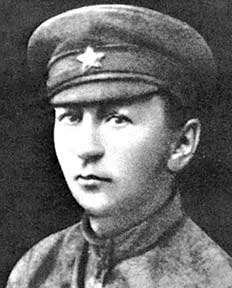
To appreciate Robert Kurka’s opera it’s necessary to have an understanding of author Jaroslav Hašek (1883-1923) and his satiric novel, The Good Soldier Schweik (also spelled Schwejk or Švejk).
In the story Hašek detailed the life and times of his fictional character, the rotund and mild-mannered Joseph Schweik, who is inducted into the army of the Austro-Hungarian Empire to fight against the Allied Powers in World War I (1914-1918).
An enthusiastic patriot, Schweik is also a lumbering idiot who, in his zealotry to carry out the orders of his superiors, succeeds only in creating havoc. But one is never certain if Schweik’s ineptness reveals his true nature or if it is clever posturing as a means of self-preservation. Whatever the case, his foul-ups keep him from reaching the war’s blood-spattered frontline, until the story’s ending, when he finally arrives at the front but disappears without a trace while on patrol.
A colorful character, as a young man Hašek was an anarchist militant before he became completely engrossed in his writing. At the outbreak of WWI the wild bohemian, writer, and radical anarchist found himself inducted into the army of the Austro-Hungarian Empire and sent to the frontline trenches to fight against the Allied Powers; it is not hard to see that The Good Soldier story was to some degree autobiographical.
While he had already invented his Schweik character and had previously written stories about him, it was during the travails of war that Hašek began to “flesh out” the character; transforming him into a good-natured buffoon that became a menace to the forces of militarism.
In 1915 Hašek was captured by the Russians and placed in a prisoner of war camp before his captors decided to employ him as a propagandist. When the Russian monarchy and its army collapsed with the 1917 Soviet revolution, Hašek joined the Bolsheviks, becoming a political commissar in the Red Army. Hašek’s allegiance to communism proved as tenuous as his loyalty to the Austro-Hungarian Empire, and after some years of living in the Soviet Union he returned to Prague in 1920, throwing himself in earnest into the completion of his Schweik novel.
Heavy drinking and ill-health overtook Hašek, who struggled to finish his masterwork. He became so sick that he stopped writing altogether, dictating to assistants the final chapters of Schweik from his sickbed. He died of tuberculosis on Jan. 3, 1923, at the age of 40; it was said that he had completed some 1,500 literary works during his lifetime – but alas Schweik would not be one of them.
Hašek had planned on Schweik running six volumes in length, but he had only created three volumes when he died (a forth was published posthumously). His old friend Josef Lada created marvelous illustrations for all the volumes, and it is his artworks that defined the bumbling good soldier. Years after his death Hašek came to be accepted as one of the most important of all Czech writers, and The Good Soldier Schweik – having been translated into 60 languages – is still the most well known work of fiction by a Czech author.
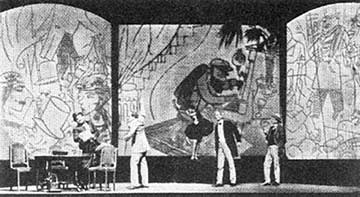
I first learned of Hašek’s masterpiece years ago through my studies of the German Expressionist movement of the late 1920s. Because of its disdain for militarism the Schweik novel was appreciated by broad sectors of the German public, who had been impoverished and exhausted by WWI.
The intelligentsia embraced the story for its pacifism and defiance of conservative social order. In 1928 Erwin Piscator (1893-1966), the German Marxist director and producer of political theater during the years of the Weimar Republic, developed a landmark stage play adaptation of The Good Soldier Schweik that he presented at the Theater am Nollendorfplatz in Berlin.
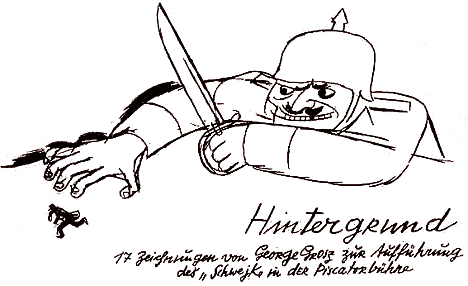
Piscator commissioned prominent playwright Hans Reimann (1889-1969) to write the play’s script, and Bertolt Brecht assisted in writing the adaptation. Edmund Meisel (1894-1930) who just three years earlier had scored the music for Sergei Eisenstein’s The Battleship Potemkin, was commissioned to compose the music. The character of Schweik was played by the famed actor Max Pallenberg.
Artist George Grosz created the stage backgrounds for the play, making hundreds of pen and ink drawings for the production. His drawings were made into an animated film that was back-projected onto the stage to coincide with the play’s action – a groundbreaking theatrical technique common to Piscator’s productions. The Long Beach Opera utilized Piscator’s idea of projected images, but its choice of images was much less effective.
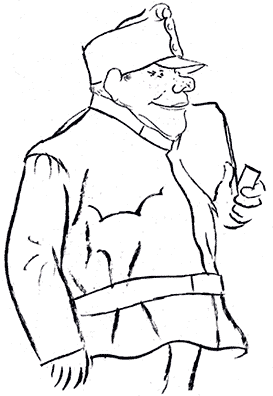
Piscator’s theories concerning what he called “epic theater” transformed the stage presenting Schweik into a motorized “arena for battling ideas,” in fact mechanized treadmills moved actors about on stage – in one scene allowing actors dressed as soldiers to march off to war without actually moving.
The intent behind Piscator’s theatrical work was to prevent audiences from losing themselves in the illusion of theater, instead making them focus on socio-political ideas. The young Bertolt Brecht would be inspired by Piscator’s ideas, making them his own.
The Schweik production included projected still photographs on the stage and auditorium walls – news headlines and text, as well as projections of motion picture films (Grosz’s animation, footage of war, and the like).
The projections were combined with other theatrical devices: audio recordings and electronic sounds, actors emerging from the audience, and giant military maps as stage scenery. Grosz wrote the following regarding his role in the Piscator production:
“It is a fact that here Erwin has created a great new area for the graphic artists to work in, a veritable graphic arena, more tempting for graphic artists of today than all that stuffy aesthetic business or the hawking around of drawings in bibliophile editions for educated nobs. Here’s a chance for our often quoted latter-day Daumiers to paint their gloomy prophecies on the walls. What a medium, though, for the artist who wants to speak to the masses, purely and simply.
Naturally a new area requires new techniques, a new clear and concise language of graphic style – certainly a great opportunity for teaching discipline to the muddleheaded and confused! And there’s nothing to be achieved with your careless impressionist brush, either. The line must be cinematographic – clear, simple, but not too thin, because of over-exposure; furthermore it must be hard, something like the drawings and woodcuts in Gothic block books, or the massive stone carvings on the pyramids.”

Grosz’s projected drawings helped to move the drama along by emphasizing aspects of the Schweik tale, but the artworks also transcended the story, becoming universal in their condemnation of war and its causes. The audience could see that Grosz was criticizing the renewed warlike direction of Germany’s ruling class, and if his projected images were not unsettling enough, Grosz would up the ante by publishing a number of the drawings in book form.
He collaborated with Wieland Herzfelde (founder of the Malik-Verlag Berlin publishing house and also the brother of well-known artist John Heartfield), in issuing a portfolio of reproductions titled, Background: 17 designs for the performance of the Schweik in the Piscator stage. The publication of the book caused a major uproar; what had been ephemeral projections could now be held in the hands of increasingly powerful critics.
Three drawings from the portfolio, Shut up and soldier on!, Bow to the Authorities, and The pouring out of the Holy Spirit, led to a right-wing campaign against Grosz and Herzfelde that resulted in the authorities charging the two with blasphemy and placing them on trial in 1928; it turned out to be one of the longest running and closely watched blasphemy trials in history.
The essence of Grosz’s drawing, The pouring out of the Holy Spirit, would be preserved by Meeropol in his libretto for Kurka’s opera in Act II, Scene Two, “Okay, let’s pray!”. In attempting to explain his Shut up and soldier on! drawing to a judge, Grosz said the following:
“This drawing was created as a cover on the book about Schweik. In one of the chapters there’s the following scene – I’ll give you the gist, because I can’t remember it exactly. Well, there are these two soldiers lying on a bed in a cell, I think, and they’re telling each other stories about their war experiences. They grumble about the war. One says to the other something like: Well, shut up and soldier on. As I read this account the drawing took shape in my imagination. I imagined that Christ might come now… They would grab him, hand him a gas mask, put him into army boots, in short, they wouldn’t understand him at all.” [Taken from notes of the blasphemy trial, published in Das Tagebuch, 1928].
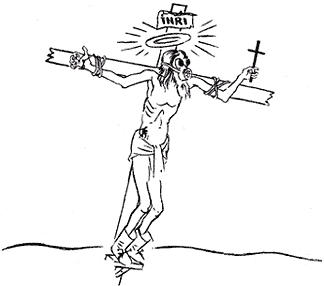
After numerous trials and retrials, Grosz and Hezfelde were acquitted in 1931, but the Schweik drawings and their printing plates were confiscated by the court and destroyed. The social forces of the burgeoning Nazi movement had scored a major victory. When Hitler came to power two years later, The Good Soldier Schweik became one of the many thousands of books destroyed during the massive public book-burnings organized by the Nazi party on May 10, 1933.
Hašek’s book was burned because it was considered “pacifist literature,” but books by “Marxists,” “liberals,” “Jews,” and anyone considered to be “un-German” were thrown onto the bonfires as well. Books by Piscator, Brecht, Grosz, and Herzfelde were also added to what the Nazis called the “funeral pyre of the intellect.”
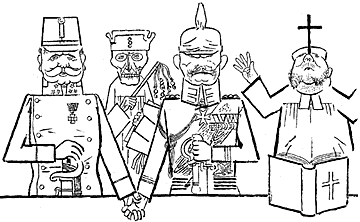
To escape Nazi persecution Grosz would flee to the U.S. in 1932. Herzfelde went underground soon after, finally escaping to Prague in 1933. Working on a film in the Soviet Union in 1933, Piscator found himself in exile when Hitler came to power. He became disillusioned with the Soviet Union under the leadership of Stalin and by 1936 he move to France, finally emigrating to the U.S. in 1939.
Piscator was invited to found a Dramatic Workshop at New York’s The New School, where his students included Marlon Brando, Harry Belafonte, Tony Curtis, Shelley Winters, and others. McCarthyism drove Piscator from America. His associate and fellow exile in the U.S., Bertolt Brecht, was brought before HUAC on Oct. 30, 1947, and interrogated regarding his political sympathies. The next day Brecht left the U.S. for Europe. Piscator did not wait to receive his subpoena, he returned to West Germany in 1951 to avoid HUAC.
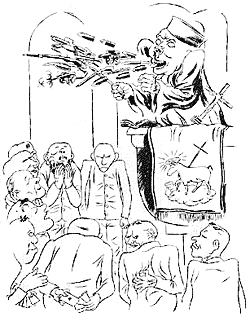
Piscator’s technical ideas regarding the staging of the Schweik play clearly have had an influence on theatre and opera over the decades. His concepts like projected backdrops, stage hands incorporated into the action as they shuffled props on and off stage, and actors performing in the aisles amongst the audience, were incorporated into the Long Beach Opera production. However, Piscator meant to provoke his audience into taking sides against war and those who profit from it, while the Long Beach Opera placed its emphasis on entertainment.
Given the profundity of Kurka’s material it would be impossible not to impart some level of political insight, and such moments were plentiful in the Long Beach Opera production. In Act I – Scene Four, Schweik finds himself in a cell at police headquarters after having been arrested for allegedly speaking against the Emperor. Many others are also in the jail for the very same offense, and all are worried about being brutalized and tortured at the hands of the police. Schweik, assuring his fellow jailbirds that things are not so bad, sings:
“I once read in a book where it said, you had to dance on red-hot iron and drink molten lead. You were shot or hanged, burned or slaughtered, and as a special event, drawn and quartered. They split you open or chopped your head, you might be innocent but you were also dead. There’s no quartering here or things of that kind, it’s improved for our benefit I’m glad to find. We’ve got a mattress, a table, a seat, they bring us soup and water and bread to eat, the slop pot is right there under your nose, a lot of progress is what it shows.”
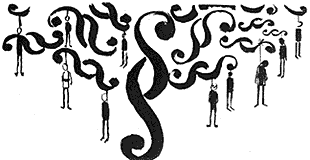
As with a number of scenes in the opera, the action in Scene Four transcends the period setting of 1914, in fact it is hard not to think of the present when hearing about the “progress” made in the handling of prisoners held by certain governments. Surely waterboarding is an improvement over being drawn and quartered – yes, a lot of progress is what it shows!
The ending scenes of the Long Beach Opera production could hardly have concluded on a more profound note. In Act II – Scene Seven, the character of Schweik at last finds himself at the front. On the stage backdrop a gigantic image is projected, a terrible scene of utter desolation; shattered and blackened skeletal trees and bomb craters cast in blue light. From behind the stage backdrop the orchestra begins the somber music for the song, “Wait for the ragged soldiers.” Groups of wounded troops walk onto the stage – collapsing, exhausted, dying, as they sing their foreboding song:
“Wait for the ragged soldiers, watch for the ragged men with their sunken faces, holding their blood-red wounds with their hands. No sound of drums when they come, no trumpets blow when they come, no flags at the gate. Wait for the ragged soldiers. Wait… wait and watch for the ragged, watch for the tired men marching slowly homeward. Men… homeward. Coat sleeves armless, legless, sightless. Angry, angry, angry men, angry men. No sound of drums when they come, No!”
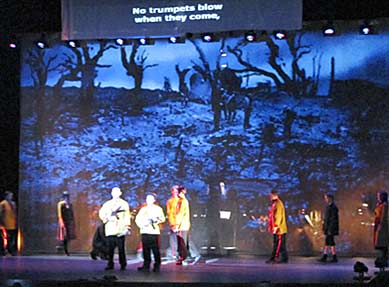
Patrolling the battlefield, Schweik and Sergeant Vanek enter the scene carrying their guns; here the production has been updated to good effect.
Rather than carrying WWI era bolt action rifles, the two soldiers are armed with modern automatic assault rifles, reminders that the sentiments of this opera are not rooted in the past, but relevant and applicable to the world as it is today.
Lost in the landscape of mangled barbed-wire and stinking corpses, Schweik and Vanek argue over which direction to take. Vanek insists that his military map indicates a right turn, Schweik shrugs and says, “Maps are sometimes wrong.” The two cannot agree on how to advance, so they part, going separate ways.
Schweik watches the Sergeant disappear into the blackened wasteland of destruction, waves goodbye, and lays down his gun. As the character of Schweik begins to walk off stage, he sings: “I’ll take a quiet road where forget-me-nots grow, along a clear stream where soft breezes blow. I’ll take it easy for the rest of the day and pick some meadow flowers on the way. I’ll take a quiet road and I’ll lie in the sun, for birds and butterflies, I won’t need my gun.” His song over, Schweik vanishes.
In the opera’s epilogue the gentleman of Bohemia returns, stepping out of the darkness and into a spotlight to find Schweik’s abandoned gun. The gentleman sings the opera’s final words:
“Schweik, Schweik, where did he go? He just disappeared and that’s all we know. Some say they saw him at a much later day, sipping a drink at a little café. And others will swear he was seen on the street, and lost in the crowd before they could meet. Schweik, Schweik, the Good Soldier Schweik, the kind of fellow that fellow men like.
In one place or other he’s sure to be found… I wouldn’t be surprised if he’s somewhere around.”

